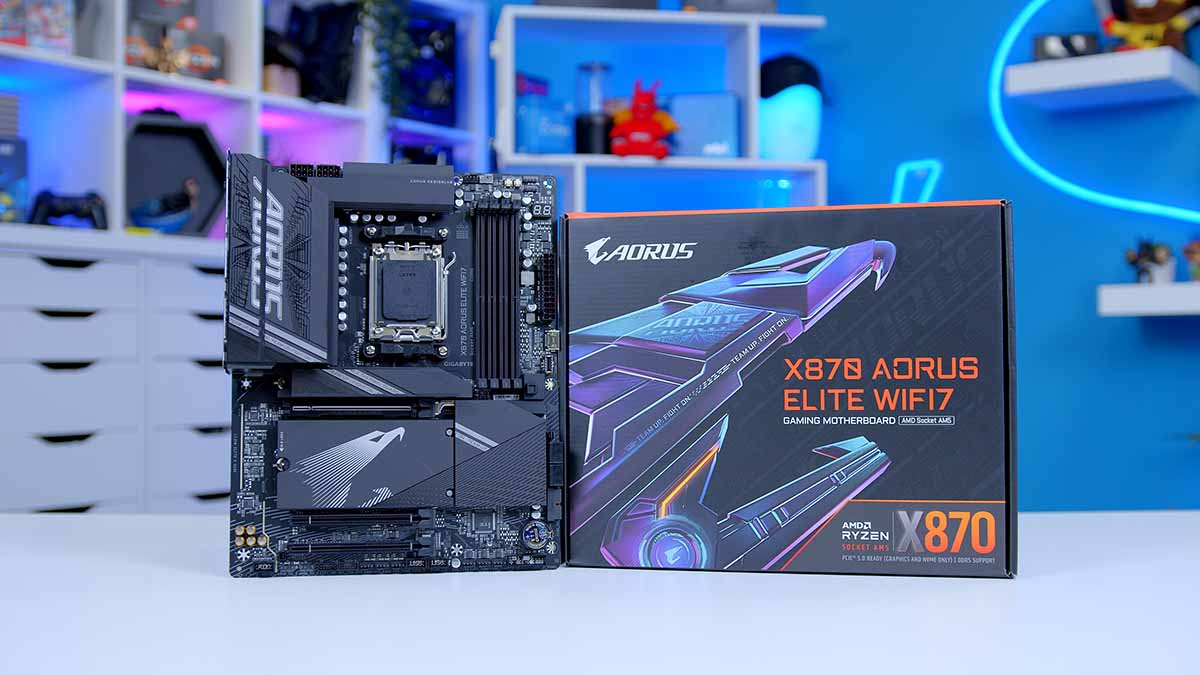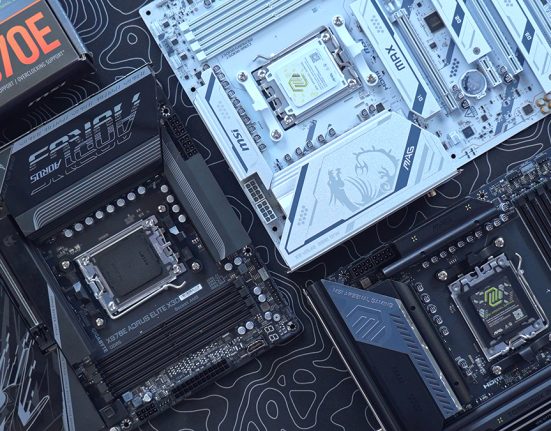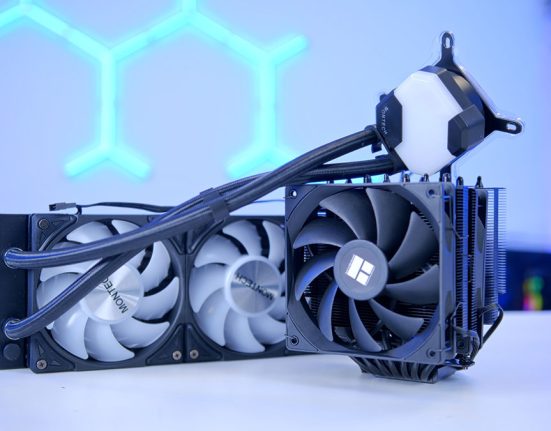The Gigabyte X870 AORUS Elite WiFi7 motherboard offers a host of new features due to the arrival of the Zen5 platform in August 2024. However, this board primarily targets the mid-range market, as it sits on the X870 chipset and is generally priced lower compared to some of the flagship ASUS boards we’ve reviewed. Despite this, it has fantastic connectivity and expansion options to provide gamers with the slots and ports they need for a solid build. We’ve put this board through the wringer with an analysis of the qualities on offer to determine if this board is worthwhile.
The main caveat with X870 motherboards is that while they are more affordable than X870E options, their feature sets are generally weaker. This means less Gen5 support, weaker overclocking, fewer expansion slots, and fewer high-speed options for the IO. However, the X670 AORUS Elite was one of our favourite boards from the Ryzen 7000 range, so we’re keen to see how the X870 version compares regarding the features on offer.
In this review, we’ll examine the Gigabyte X870 AORUS Elite WiFi7 motherboard’s primary qualities, including its specs, design, box items, features, and more.
Buy the Gigabyte X870 AORUS Elite WiFi7 on:
Specification
Looking at the specs, the Gigabyte X870 AORUS Elite WiFi7 has retained the ATX form factor, which is good to see. While we appreciate that some builders may prefer an E-ATX board, these aren’t supported as much as ATX options.
We can immediately see that overclocking speeds are weaker here than some of the flagship ASUS X870E motherboards. The X870 AORUS Elite supports up to 8000MT/s, while other boards can reach 8400MT/s or 8600MT/s speeds. This isn’t a deal-breaker for us because 600MT/s doesn’t make a huge noticeable difference in performance. It’s also worth noting that this board offers a max capacity of 256GB, while ASUS boards are restricted to 192GB.

This board offers a 16+2+2 VRM power phase configuration, which is more than enough for a decent overclock. The power delivery remains the same compared to the X670 version. However, Gigabyte has included some AI software features to make overclocking simple.
The expansion is solid for a board of this calibre. There’s a single Gen5 graphics card slot ready for the next generation of cards. In terms of storage, there are three Gen5 M.2 slots and one Gen4. It’s great to see that there are four slots, and we can appreciate that there’s a Gen4 option here instead of four Gen5 drives to save some costs.
| Specification | Gigabyte X870 AORUS Elite WiFi7 |
|---|---|
| Form Factor | ATX |
| Supported Memory | 256GB DDR5 8000MT/s |
| PCI-E x16 Slots | 1 x PCI-E 5.0 1 x PCI-E 4.0 |
| PCI-E x4 Slots | 3 x PCI-E 5.0 1 x PCI-E 4.0 |
| VRM Power Phases | 16+2+2 |
| Front IO | 1 x USB 3.2 Gen2x2 Type-C 1 x USB 3.2 Gen1 Type-A 2 x USB 2.0 |
| Rear IO | 2 x USB4 Type-C 4 x USB 3.2 Gen1 Type-A 4 x USB 2.0 2 x USB 3.2 Gen2 Type-A |
| Audio | 1 x Optical S/PDIF 2 x Audio Jacks |
| Networking | 2.5 Gigabit LAN WiFi 7 |
The IO on the X870 AORUS Elite is a bit of a mixed bag. On the front, there are four headers: one USB 3.2 Gen2x2 Type-C (one port), one USB 3.2 Gen1 header (two Type-A ports), and two USB 2.0 headers (four ports). This is slightly different from the X670 AORUS Elite, with the removal of a USB 3.2 Gen1 header, but I’d argue this is fair.
Twelve ports are featured on the rear: two USB4 ports, four USB 3.2 Gen1 Type-A ports, four USB 2.0 ports, and two USB 3.2 Gen2 Type-A ports. The number of ports is acceptable, but it feels like USB 2.0 ports have been used to pad out the connectivity options. I’d rather see fewer ports so there’s more bandwidth and a significant number of higher-speed ports. USB 2.0 is useful for low-speed peripherals but doesn’t serve much of a purpose beyond that, such as bolstering the connectivity options.
The rest of the IO options are similar to those available on the X670 version of this motherboard, apart from a couple of differences. An optical S/PDIF port on the X870 AORUS Elite is ideal for those with soundbars or more complex audio setups. Additionally, WiFi 6E is now WiFi7, providing better bandwidth and stability for those with a supporting router.
What’s in the Box?
In all of our motherboard reviews, we examine what comes in the box. Manufacturers typically provide extra cables or accessories that streamline the building process, so we’ll look at those now!
The WiFi 7 antenna is one of the main accessories you’ll need to fully utilise this standard. This antenna isn’t dissimilar from the ASUS WiFi antenna, but the Gigabyte iteration lays down instead of standing up.

Additionally, the quick-connect mechanism for attaching the antenna to the rear IO isn’t the same. Where ASUS uses two quick connectors, Gigabyte has a single conjoined connector, making it easy to plug in.
Unfortunately, this board only comes with extra accessories besides the WiFi antenna. The first is some SATA data cables. This standard isn’t as heavily used anymore, but those with older storage devices won’t need to buy any extra cables.

The last item is a Q-connector. These are used to wire up JFP1 front panel power if JFP1 uses individual pins. This will be useful in some instances, but many modern chassis use a unified header for front panel power, which makes the Q-connector somewhat redundant.

Gigabyte X870 AORUS Elite WiFi7 Design
The design of the X870 AORUS Elite WiFi7 is similar to that of the X670 AORUS Elite AX. This board is primarily black, with a dark PCB and slightly grey heatsinks towards the centre. The rear IO heatsink now shows the AORUS text instead of the logo. And there’s some RGB lighting underneath the heatsink at the bottom right of the PCB.

Overall, I think the aesthetic of the X870 AORUS Elite is fine. There’s nothing particularly outstanding or impressive. The board is primarily black, so it looks good with other dark components. The rugged contrast of the PCB and some of the components on the board poking through will appeal to some, but I’d personally prefer this board to have more heatsinks.

The AORUS Elite range has always taken a minimalistic approach to design. They’ve never been as flashy as the ROG Strix boards from ASUS, but their simplicity is appreciated.

Gigabyte has missed a trick by not having the AORUS text on the rear IO heatsink light up. However, this likely comes down to cost-saving measures, like the slightly more restrictive IO and connectivity options. The design of the Gigabyte X870 AORUS Elite WiFi7 will appeal to many prospective buyers, but there are nicer-looking boards out there for those with a bit more cash.
Connectivity Options
Graphics Card Slots
The main graphics card slot is Gen5 compatible, ready for the next generation of graphics cards. This is the only slot on the board that operates at full x16 speeds, so this is where your graphics card must be installed.

There are two additional GPU slots at the bottom of the board. The topmost of the two is Gen4, while the other is Gen3. The former runs at x4 speeds, while the latter is an x2 slot. Compared to the X670 version of this board, it’s great to see Gen5 compatibility on the X870 chipset, as the X670 AORUS Elite doesn’t have any Gen5 GPU compatibility.

M.2 Slots
All of the storage slots are located relatively close together. From top to bottom, you’ve got access to three Gen5 slots and a single Gen4 slot. The primary SSD M.2 slot is located underneath a heatsink, which can be easily removed by pushing the EZ-Latch mechanism, a handy usability feature.

The rest of the M.2 drive slots are underneath the larger heatsink towards the middle of the board. Again, this heatsink is tool-less and can be removed through the EZ-Latch instead of loosening any screws. It’s good that there are ample storage options on a cheaper board, and we’re glad that most of these slots are Gen5 rather than Gen4.
RAM DIMMs
The supported RAM on the X870 AORUS Elite is relatively standard. There aren’t any significant differences compared to the X670 version of this board. It supports a max capacity of 256GB with speeds up to 8000MT/s. The more interesting point to note is that the supported capacity on this board is better than the X870E ASUS boards, which are restricted to 192GB.

Rear IO
The selection of rear IO on this board is pretty decent. As we’ve discussed in the specs section, there are twelve ports here, most of which are high-speed. It’s a shame that there’s so much USB 2.0, but we understand this was likely done to bolster the available ports. Networking is solid, with 2.5 Gigabit LAN and WiFi 7 support. The optical S/PDIF out is also a solid value-add for those with a speaker setup.

Internal Headers
CPU and Motherboard Power
The motherboard power header on this board is pretty standard for a mid-range option. The X870 AORUS Elite WiFi7 uses a 24-pin motherboard header. This board isn’t specifically geared towards overclocking, so it doesn’t have an additional 8-pin header underneath.

Again, CPU power is pretty standard. At the top left of the motherboard, there are two 8-pin EPS headers. We recommend plugging in both headers, which spreads the power delivery better and helps with thermals.

Front USB Headers
The front USB headers on the X870 AORUS Elite WiFi7 are in their usual places. USB-C, which uses the USB 3.2 Gen2x2 standard and supports one port, sits just beneath motherboard power.

This board has one USB 3.0 header, accommodating two USB 3.2 Gen1 Type-A ports. This right-angled header is situated below the SATA data ports.

The USB 2.0 headers are underneath the third PCI-E x16 slot. These accommodate two ports each, for a total of four. A couple more USB 2.0 headers would be ideal, but two should be enough for most builders.
Pump and Fan Headers
The pump and fan headers on the X870 AORUS Elite WiFi7 aren’t located in their traditional spots. The top of the board is generally reserved for ‘CPU_OPT’, ‘CPU_FAN’, and ‘AIO_PUMP’. While the two former are here, the rest are at the bottom of the PCB.

I was pretty impressed with how well-organised all of the fan headers are. These all sit just below the Gen3 PCI-E x16 slot. From left to right, you’ll find ‘SYS_FAN1’ to ‘SYS_FAN4’ followed by two pump headers labelled ‘FAN5_PUMP’ and ‘FAN6_PUMP’. These are all 4-pin PWM headers. This board has many headers for fans and coolers, which is great to see.

RGB Headers
There are four RGB headers on this board. Two are at the top right and the other at the bottom left. Of the two at the top right, one is a 4-pin header that isn’t addressable, and the other is a 3-pin style that is addressable. The other headers at the bottom left are also addressable.

Most boards generally have around three addressable headers. It would be better if there were more, but three is a solid number, especially if you have splitters.
SATA Data Ports
In the wake of NVMe SSDs, SATA data has become far less popular as a general rule. However, those with SATA SSDs or hard drives have four ports on this board.

Building with the AORUS X870 Elite WiFi7
Building with the AORUS X870 Elite WiFi7 has been incredibly simple. Strangely, with the arrival of this new platform, manufacturers have gone to great lengths to simplify many of the new boards’ building features. This means there are far more tool-less mechanisms to make installing components incredibly simple.
The Gigabyte AORUS X870 Elite WiFi7 offers a range of helpful design qualities that make building straightforward, such as the tool-less latches for the heatsinks or the click mechanisms for the SSD drives. This minimises the use of tools and screws. Because this board uses the ATX form factor, it easily slips inside a modern case without any clearance issues.
Overall, building a PC with this board was enjoyable. Compared to the previous generation X670 version, the X870 board has some significant improvements that make it worth considering.
Features We Like
Tool-Less Mechanisms
Like the ASUS X870 range, this Gigabyte X870 AORUS Elite WiFi7 motherboard features a wide selection of tool-less mechanisms that make building a PC hassle-free. For example, pushing on the latch can remove the primary SSD heatsink. It also clicks into place when it is reinstalled. The graphics card has a large button to pull the PCI-E latch down, making the GPU removal simple.

The SSD drive slots also have a tool-less latch that secures the drives without needing any tools. This is very handy if you don’t have any M.2 screws spare.
Diagnosis & Troubleshooting
At the top right of the motherboard, there is a Q-Code LED alongside a set of EZ debug LEDs. If you run into trouble during the boot process, these will help you narrow down the issue.

Features We Don’t Like
Needs More Heatsinks
Generally, I think the X870 AORUS Elite WiFi7 is well-designed. However, one of the main caveats of this board is that it only has a couple of heatsinks. Some prospective buyers will appreciate the more barebones style of the board with parts of the PCB poking through. I think more heatsinks would provide a well-rounded aesthetic and improve thermal capabilities, similar to what Gigabyte did with their B650E AORUS Stealth board.

Conclusion
Gigabyte X870 AORUS Elite WiFi7
Product Name: X870 AORUS Elite WiFi7
Brand: Gigabyte
-
Features
-
Design
-
Performance
-
Value For Money
Summary
The Gigabyte X870 AORUS Elite WiFi7 is a solid value motherboard that offers a well-rounded set of modern features. Compared to the X670 version of this board, a range of features and design qualities have remained the same, but there are also some pretty significant changes. There’s widespread PCI-E 5.0 compatibility, better overclocking support, plenty of expansion options, and a vast selection of tool-less mechanisms that streamline the building process. Additionally, this is one of the cheaper X870-based boards we’ve looked at, making it a competitor purely from an affordability point of view.
That being said, there are some areas in which I would improve. Firstly, I think the design could be better. This is more of a minimalist board, but some more heatsinks would streamline the look a little more, tidying up the PCB. Additionally, I think this board should have more high-speed ports and far less USB 2.0. The four USB 2.0 ports on this board bolster the number of options available, but it would be nice to see an increased amount of USB 3.0 as they’re incredibly versatile. Despite this, the X870 AORUS Elite WiFi7 still offers massive value for those looking for an affordable mid-range option.
Pros
✅ Solid storage options
✅ Tool-less mechanisms
✅ Useful debugging features
Cons
❌ Lacklustre design
❌ Benefit from more heatsinks
❌ Too many USB 2.0 ports





![FI_[DM82] TT MineCUBE Build](https://geekawhat.com/wp-content/uploads/2025/12/FI_DM82-TT-MineCUBE-Build-551x431.jpg)
![FI_[DP056] Antec flux M + 9060XT](https://geekawhat.com/wp-content/uploads/2025/12/FI_DP056-Antec-flux-M-9060XT-551x431.jpg)

